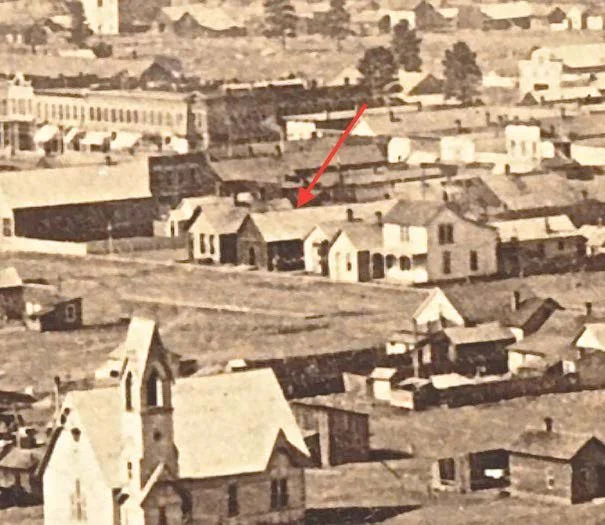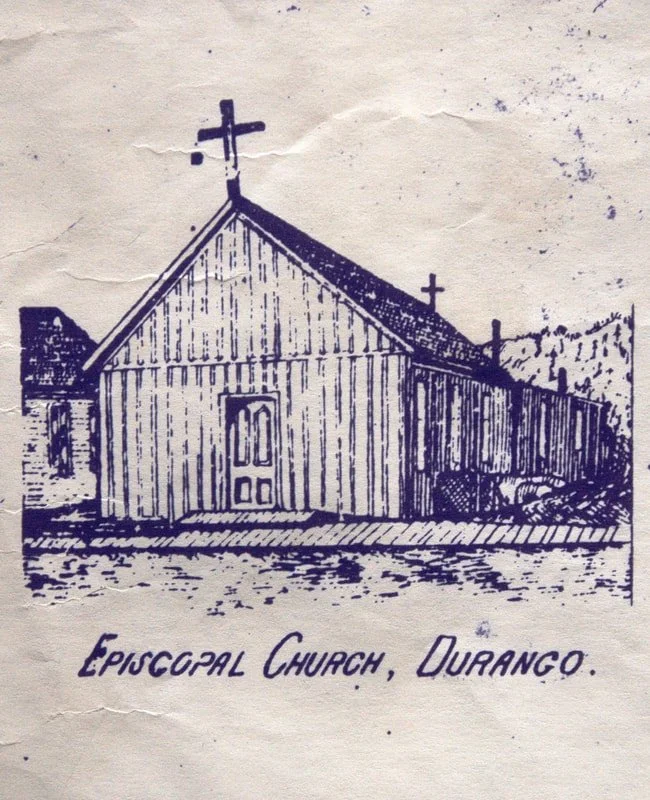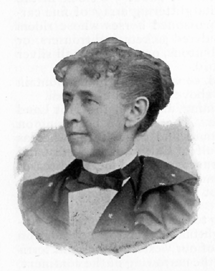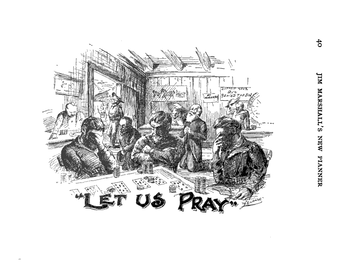Our Living History
The First Celebration of Christmas, 1881
by John A.K. Boyd, MD
The first St. Mark’s Episcopal Church, Durango, Colorado, was built in the fall of 1881 by Parson Hoge with his own hands and help from local carpenters. It was a simple rectangular wooden structure with a sawdust floor. Preparations for the first Christmas celebration in the new building began on December 21st of that year. According to the December 22, 1881, edition of the Durango Herald:
"All the young folks and many of the older ones, connected with St. Mark’s Church were busily engaged in decorating the church with evergreens for Christmas, last evening, and in putting up a grand, big Christmas tree to make the children’s hearts happy, next Saturday evening. The church will be in gala attire next Sunday. Besides the holiday evergreens, with which its walk will be festooned, it will have a brand new carpet on the floor, its pews will be handsomely decorated with Durango’s good looking people, and the pulpit will be occupied by St. Mark’s genial pastor, with a stirring Christmas sermon."
With regard to the Christmas preparations, a later edition of the Herald also noted:
"… the industrious ones, who were engaged in decorating St. Mark’s Church with evergreens for Christmas, returned to Scott’s Hall [a local dance hall with a fine wooden floor] at ten o’clock, and rewarded themselves with a little dance. Their hands bore deep evidence of their labors in pine pitch, but no one was allowed the privilege of removing it, and the fun was even greater for its informality. In some cases, where the pitch was thickest and blackest, (denoting the extra industry of the owner of the hands!) mittens and miter gloves were resorted to, but these were very generally discarded before twelve o’clock."
On December 29, 1881, the Herald reported:
“Sunday [Christmas Day] found St. Mark’s church all ready for the merry holiday season. And an attractive place of worship it was. Over the altar, in evergreen letters, were the words, “Praise to God on high.” Under them was the sacred Latin cross, placed between the Maltese and Greek crosses. The walls of the room were festooned with wreaths of evergreens, and over the front door, surmounted with a half circle and Greek cross, were the words, “Peace on Earth.”
The Sunday School Christmas entertainment at the St. Mark’s church was a very pleasant affair. All the children were there, of course; and were made happy, before the beautiful Christmas tree was unloaded. After a short address by the pastor, Rev. C. M. Hogue, a song, entitled “Christmas Time Has Come Again,” was sung by Misses Lizzie Wigglesworth, Lily Luttrell, Louisa Weinig, and Stella Steinwandel. “Annie and Willie’s Prayer to Santa Claus,” was recited by Lizzie Wigglesworth. Theodore Langoff spoke “The Night Before Christmas.” Robbie Hopkins recited a pretty little Christmas poem, and Clara Smith told the story of “The Bad Doll.” Little May Finch brought down the house with her singing of “Beautiful Little Hands.” She also recited “Sweet Maiden Fair,” receiving great applause. Readings were given by Louisa Weinig, Minnie Shields, Horace Sims and Eddie Casebolt. “Christmas Bells” was a solo sung most charmingly by Miss Alice McFadden. Miss Annie Willard closed the programme of the evening by reciting a poem of great beauty. A collection for the benefit of the Sunday School library was then taken up in the large audience with good results. After a short address by the Sunday School Superintendent, Mr. Walters, in which he gave the information that the school had only been started last January, Santa Claus appeared in a wooly coat and bells, and Mr. W. G. Kellog proceeded to unload the gay looking Christmas tree and to load up old Santa (who, when you got below the clever disguise, turned out to be none other than Mr. J. A. Smith). To every little girl he presented a doll and to the little boys, knives; and all were served equally with picture books, handkerchiefs, harmonicas, oranges, and bags of candy. Besides these the parents and friends enriched the tree with many handsome and more costly gifts; but all fared exceedingly well. Thus closed the first Christmas entertainment at St. Mark’s church.
Caroline Westcott Romney
Caroline Westcott Romney – St. Mark’s Best Known, Albeit Imperfect, Saint
A Sermon Preached by Kip Boyd, St. Mark’s Historian
All Saints’ Day, November 5, 2023
Caroline Westcott Romney is arguably St. Mark’s most memorable (albeit imperfect) saint. In 1881 she was not only a charter member of the church, she was also the owner-editor of Durango’s first newspaper, The Durango Record.
Parson Charles Montgomery Hoge
Durango’s First Episcopal Priest
Charles Montgomery Hoge (1832-1904)
John A.K. Boyd, MD, St. Mark’s Episcopal Church Historian, Durango, Colorado
updated 06-25-23
According to a family history written by his nephew, Albert J. Hoge, in 1928, Charles Montgomery Hoge left Fayetteville, Arkansas, and headed west in 1857 at the age of 25 in the company of his father, Judge Joseph Montgomery Hoge, his brothers James and Horace, his new bride, Elizabeth Colville, and her brother John. They were looking to start a new life in California following the sad death of Charles’ mother. Having secured places on a wagon train led by Basil Parker, they crossed Texas and Colorado joined to the ill-fated and much larger Fancher wagon train. By the time the Fancher train reached Salt Lake City, the Parker train had lagged 2-3 days behind. The Fancher train, which now included Elizabeth’s brother John, took the southern route across Utah and perished in the Mountain Meadow Massacre when they were attacked by a band of militant Mormons. Arriving later in Salt Lake City, Parker heard rumors of troubles to the south, and took his wagon train across the northern route, arriving successfully in California where the Hoges settled around Monterey.
Phillip B. Hawley
St. Mark’s Era, 1945-1964
The Rev. Phillip B. Hawley was called from All Saints Episcopal Church, Torrington, Wyoming, to become the vicar of St. Mark’s Episcopal Church, Durango, Colorado, on June 8, 1945. One year earlier (May 5, 1944) he had married Shirley Moon at St. Peter’s Church, Sheridan Wyoming. He arrived in Durango in July of 1945 with a very small baby daughter (Mary) and a wife who could play the organ! Prior to Fr. Hawley’s arrival, the parish formed a housing committee and secured a new rectory (with furniture) for $5,700, after obtaining a loan from the Colorado Diocese for $4,500. That house with a red tiled roof still stands at the corner of West 7th Street and West 2nd Avenue. There were evidently some plumbing problems in the rectory because the Vestry Minutes of February 1947, taken by Judge James Noland (the temporary secretary of the Vestry) noted: “Discussion was had concerning the Vicar’s toilet seat – the vicar reported that the top of the reservoir strikes him in the middle of the back, and that in order to sit down he has to crawl under the wash bowl and hold onto the bath-tub pipe. It was agreed that something should be done for the Vicar’s relief.” By June of 1947, one of the church wardens reported that he had “ordered necessary reparis [sic] and toilet facilities in the rectory.”
Fr. Walton Hall Doggett
by John A.K. Boyd, MD
Version 2/25/2019
By 1907 St. Mark’s Episcopal Church in Durango had lost its parish status , and by the end of that year the number of communicants attending services had dwindled to about 35 per week. Despite this, the church continued to elect vestries, celebrate weddings and hold Christmas tree ceremonies. An organ was installed, and a furnace was built. In 1908 the Reverent Walton H. Doggett, a cigar smoking priest who loved to fish, arrived in Durango. He also loved to give sermons. Every Sunday, his morning homily was different from the one he gave on Sunday evening. He often used a large chart to illustrate his messages. Many of his sermons were based on church seasons or specific scriptural texts. Occasionally he presented discourses on “last things”: “The Church Expectant,” “The Divine Purpose for Humanity,” and “The Modern Interpretation of Eternal Punishment.” But his most consistent topics tended to be on practical Christian coping with everyday life: “The Indwelling Christ,” “The Penalty of Hate,” “The Dignity of Work,” “The Value of Man,” “Hurry and Worry” [there should be a balance between procrastination, the thief of time, and hurry, the enemy of reflection], “Religion on a Business Basis,” “Our Duty to Our Neighbor,” and “Present Day Conditions and Their Lessons For Us.” One sermon was titled, “A Vacation and What It Accomplished.” This sermon was given on the Sunday following the Durango Herald’s article of August 29, 1908, which noted that “Mr. Doggett reports a fine vacation, fishing on the Piedra and with Mr. John Pearson in Hermosa Park.”







